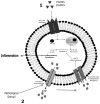Mechanisms Underlying Connexin Hemichannel Activation in Disease
- PMID: 33800706
- PMCID: PMC8036530
- DOI: 10.3390/ijms22073503
Mechanisms Underlying Connexin Hemichannel Activation in Disease
Abstract
Gap junctions and connexin hemichannels mediate intercellular and extracellular communication, respectively. While gap junctions are seen as the "good guys" by controlling homeostasis, connexin hemichannels are considered as the "bad guys", as their activation is associated with the onset and dissemination of disease. Open connexin hemichannels indeed mediate the transport of messengers between the cytosol and extracellular environment and, by doing so, fuel inflammation and cell death in a plethora of diseases. The present mini-review discusses the mechanisms involved in the activation of connexin hemichannels during pathology.
Keywords: connexin hemichannel; mechanism; pathology.
Conflict of interest statement
The authors declare no conflict of interest.
Figures


References
Publication types
MeSH terms
Substances
Grants and funding
LinkOut - more resources
Full Text Sources
Other Literature Sources
Research Materials
Miscellaneous

